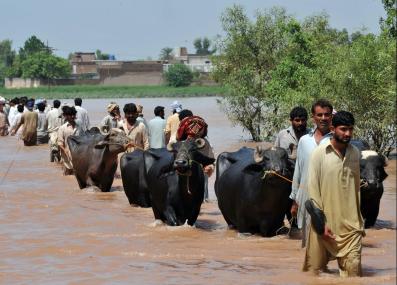Have a question?
How are countries held accountable under the Paris Agreement?
The short answer is that there is no hard enforcement in the Paris Agreement. But all the members regularly meet, share progress, and renew their pledges of climate action, encouraging every country to step up its commitments.
Updated August 8, 2025
The Paris Agreement is a diplomatic agreement that brings the world together in a common effort to combat climate change. The most important piece of this agreement is that all members must make pledges of action every five years to lower their greenhouse gas emissions. Those pledges are called their “Nationally Determined Contributions” (NDCs). For example, the European Union's most recent NDC pledges to cut emissions to at least 55% below 1990 levels by 2030.
But while countries are required to submit these pledges, the content is up to them: Members get to decide for themselves what to promise in their NDCs. So what would make a country make a strong pledge and then stick to it?
The short answer is that there’s not much formal accountability. Instead, says Michael Mehling, Deputy Director of the MIT Center for Energy and Environmental Policy Research, the focus is on accurate reporting. “Every country has to send periodic reports on what they’re doing,” says Mehling, “in the form of national emissions inventories and progress towards achieving their NDCs.” The main formal consequence for a member failing to meet its targets is a meeting with a global committee of neutral researchers. The committee will work with struggling members to create new plans.
So the main reason for countries to make strong NDCs isn’t fear of being “punished” under the Paris Agreement—it’s because their citizens and allies want them to cooperate on fighting climate change. “It’s not so different from what’s driving more and more companies to take on voluntary emission targets,” says Mehling. “They know shareholders and customers expect it, and it’s partly becoming a matter of saving face.” And as more countries make strong pledges of climate action, governments also see economic opportunities in taking the lead on the low-carbon technologies of the future. “There is something of a virtuous circle at play here,” Mehling adds. “The question is only whether it will all add up to sufficient climate efforts, and do so fast enough. But it’s the best we have.”
Developing countries also need funding and aid to meet their NDCs. The second major feature of the Paris Agreement is a commitment from wealthier countries to provide financial and technological assistance to the developing world—including countries with very large but still developing economies like China.
As with the NDCs, the Paris Agreement does not set hard standards for this aid, so it is largely up to members to decide how their funds can be used and track the results. “The process [of transferring funds] is very heterogeneous—many countries do many different things, so it can be difficult to keep tabs on what was contributed where and when,” says Mehling.
Most donor countries transfer funds through existing channels, like UN programs or their own foreign aid offices. The United Nations has also set up a few central channels for giving out aid. The Green Climate Fund is the official UN entity for climate financing—though it only channels a small fraction of the aid the Paris Agreement and previous decisions call for. The UN has also approved the Global Environment Facility, a large international aid mechanism, to provide its own grants to countries, setting aside special funds for key priorities like helping developing countries adapt to climate disasters. Both these institutions have their own accounting mechanisms to track and audit funding.
It might seem like the Paris Agreement is a very loose arrangement, with few controls on how its members meet their commitments. In fact, this very flexibility, combined with regular, transparent sharing of information, is a big reason the Agreement was able to win approval by nearly every country in the world. “It succeeded in getting universal participation and agreement to these obligations of conduct,” says Mehling. “And it’s also open-ended. Where the Kyoto Protocol [the previous UN international treaty to fight climate change] was restricted to a short time period, this agreement creates a strong framework to have ongoing negotiations, and to set expectations with long-term targets that will keep us on track.”
Thank you to George Reppucci of Manhattan Beach, California, for the question. You can submit your own question to Ask MIT Climate here.
Submit your own question to Ask MIT Climate
Get the latest from Ask MIT Climate monthly in your inbox









